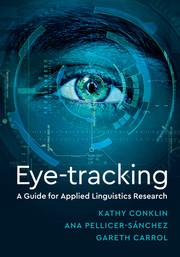Book contents
- Frontmatter
- Contents
- Figures
- Tables
- Preface
- Chapter 1 Introduction to Eye-Tracking
- Chapter 2 Choosing the Equipment
- Chapter 3 Practicalities of Eye-Tracking
- Chapter 4 Researching Reading
- Chapter 5 Researching Listening and Multimodal Input
- Chapter 6 Using Eye-Tracking in Other Contexts
- Chapter 7 Working with the Data
- Chapter 8 Conclusions
- References
- Index
3 - Practicalities of Eye-Tracking
Published online by Cambridge University Press: 14 September 2019
- Frontmatter
- Contents
- Figures
- Tables
- Preface
- Chapter 1 Introduction to Eye-Tracking
- Chapter 2 Choosing the Equipment
- Chapter 3 Practicalities of Eye-Tracking
- Chapter 4 Researching Reading
- Chapter 5 Researching Listening and Multimodal Input
- Chapter 6 Using Eye-Tracking in Other Contexts
- Chapter 7 Working with the Data
- Chapter 8 Conclusions
- References
- Index
Summary
Designing an Experiment
Designing and building an eye-tracking study can be a daunting task. In this chapter we will walk through the practicalities of planning, creating and running a study from beginning to end. The specifics of how to actually build an experiment vary according to the type of study we want to run and the eye-tracking system we are using. Our aim is not to provide a ‘how-to’ guide as such, but to talk about the key components and general issues that will be important to most studies. We will also give a brief introduction to the three systems that were discussed in Chapter 2: SR Research EyeLink (www.sr-research.com), Tobii (www.tobii.com) and SMI (www.smivision.com) eye-trackers. As with most things, the best way to learn how to build an eye-tracking study on any of these systems is to dive in and try for ourselves. A good approach is to first look at an existing, similar study – if possible observing an experienced user as he/she builds an experiment – to see the ‘dos’ and ‘don'ts’, then to try editing and building a study of our own.
The first question we should ask is whether eye-tracking is even the best methodology to use. It is tempting to adopt new technologies even when a different approach might produce more useful data, so we should first consider the alternatives to decide whether this is the best option for our research purposes. As with any experiment in any field, the research question should inform the methodology and design, rather than the other way around. Reading extensively around our topic will show us how other researchers have chosen to study it, and this should help us to decide whether eye-tracking is a good choice. Assuming that this decision has been made (and that the answer was yes), this chapter addresses some of the things we will need to consider to get started. We will begin by describing the process of preparing stimuli and building an experiment, then discuss factors such as selecting suitable participants, setting up and calibrating the eye-tracker, and collecting and saving data.
First of all, we need to try to conceptualise our experiment as clearly as we can. Normally we start with a set of general questions that are not specific to eye-tracking, but which are important when designing any language study.
- Type
- Chapter
- Information
- Eye-TrackingA Guide for Applied Linguistics Research, pp. 33 - 79Publisher: Cambridge University PressPrint publication year: 2018



